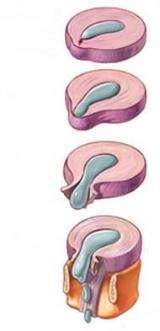Dr Nigel Kellow, Consultant Interventional Spine and Pain Physician explains what is happening to our spines as we grow older, and how what is often referred to as a slipped disc - should really be called a herniation or prolapse.
As we grow older the first degenerative changes generally seen in the spine are within the intervertebral discs themselves.
The nucleus of the spine starts to become dehydrated. As this drying out progresses the nucleus shrinks and the disc starts to lose it's cushioning effect. The annulus can also weaken and split (see diagram), most often at the back of the disc, where the spinal cord and nerve roots to the arms and legs lie. With the high pressures inside intervertebral discs as a result of standing upright a split in the annulus allows material from the nucleus to push backwards towards the weakness. This causes a bulge in the disc, which is known by several different terms, such as disc bulge, prolapse, or herniation, but it is more widely known as a “slipped disc”. Sometimes the annulus splits completely allowing nuclear material to enter the spinal canal.
Disc Herniations, Sciatica and Brachialgia
Slipped discs - or what we now call disc herniations tend to occur most at the lower end of the lumbar spine and also in the lower levels of the cervical spine. These herniations can cause pain in the back or in the neck, but more often they cause severe burning pain in a line down the leg or arm due to pressure from the bulging disc or nucleus material pressing on a nerve root. This nerve root pain is generally excruciating and does not respond very will to conventional painkillers. When the nerve pain is in the leg and due to a lumbar disc herniation it is called sciatica. When it is in the arm and due to a cervical disc herniation it is called brachialgia.
The pain from disc herniations tends to subside after a few days or weeks with simple painkillers. If it is problematic injections of steroids guided by x-ray or CT around the affected nerve root can be very effective at relieving pain. If pain persists despite several image guided spinal injections of steroids or if there are neurological complications such as weakness in the arm or leg, then the an operation is indicated to remove the offending material.
For further information - see The Ageing Spine and Understanding Pain and Pain Killers
Associated with the nervous system and the brain.
Full medical glossary








